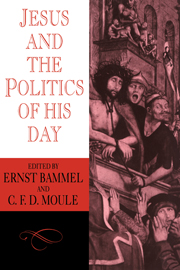Book contents
- Frontmatter
- Contents
- Abbreviations
- Foreword
- The Zealots and Jesus
- The revolution theory from Reimarus to Brandon
- The date and character of Mark
- Some observations on Tendenzkritik
- Argumentum e silentio
- The Poor and the Zealots
- The opposition between Jesus and Judaism
- Judaeo-Christianity and the Jewish establishment, A.D. 33–66
- A.D. 70 in Christian reflection
- The trial of Jesus in the Acta Pilati
- Christ as brigand in ancient anti-Christian polemic
- Jesus as a political agent in a version of the Josippon
- The Feeding of the Multitude
- The coin of ‘Render unto Caesar …’ (A note on some aspects of Mark 12: 13–17; Matt. 22: 15–22; Luke 20:20–26)
- Render to Caesar
- The Temple tax
- ‘Not peace but a sword’: Matt. 10:34ff; Luke 12: 51ff
- The decision of the Supreme Court to put Jesus to death (John 11:47–57) in its context: tradition and redaction in the Gospel of John
- The ‘triumphal’ entry
- The two swords (Luke 22: 35–38)
- The titulus
- Romans 13
- Biblical criticism criticised: with reference to the Markan report of Jesus's examination before the Sanhedrin
- The political charge against Jesus (Luke 23: 2)
- The trial before Pilate
- ‘His witness is true’: A test of the Johannine claim
- Index of Authors
- Index of References
The two swords (Luke 22: 35–38)
Published online by Cambridge University Press: 19 January 2010
- Frontmatter
- Contents
- Abbreviations
- Foreword
- The Zealots and Jesus
- The revolution theory from Reimarus to Brandon
- The date and character of Mark
- Some observations on Tendenzkritik
- Argumentum e silentio
- The Poor and the Zealots
- The opposition between Jesus and Judaism
- Judaeo-Christianity and the Jewish establishment, A.D. 33–66
- A.D. 70 in Christian reflection
- The trial of Jesus in the Acta Pilati
- Christ as brigand in ancient anti-Christian polemic
- Jesus as a political agent in a version of the Josippon
- The Feeding of the Multitude
- The coin of ‘Render unto Caesar …’ (A note on some aspects of Mark 12: 13–17; Matt. 22: 15–22; Luke 20:20–26)
- Render to Caesar
- The Temple tax
- ‘Not peace but a sword’: Matt. 10:34ff; Luke 12: 51ff
- The decision of the Supreme Court to put Jesus to death (John 11:47–57) in its context: tradition and redaction in the Gospel of John
- The ‘triumphal’ entry
- The two swords (Luke 22: 35–38)
- The titulus
- Romans 13
- Biblical criticism criticised: with reference to the Markan report of Jesus's examination before the Sanhedrin
- The political charge against Jesus (Luke 23: 2)
- The trial before Pilate
- ‘His witness is true’: A test of the Johannine claim
- Index of Authors
- Index of References
Summary
‘This record of Jesus' arming of his disciples, or rather his checking on their armament’, remarks S. G. F. Brandon, ‘has greatly troubled commentators’. The idea that Luke 22: 36–8 really presents Jesus as acting like an officer ‘checking’ his men's weapons before battle is bizarre; but that the commentators have floundered in a morass of perplexity when faced with this notoriously difficult passage is undoubtedly true. Brandon cites examples of the diverse explanations of exegetes, including myself, who have tried rather desperately to establish the meaning, and indeed to make any sense at all, of this strange pericope. A longer list of interpretations was collected by T. M. Napier, representing the period from Wellhausen to 1938, and they make discouraging reading.
The first question to be considered in any attempt to elucidate Luke 22: 38 (‘And they said, “Lord, see, here are two swords.” And he said, “It is enough.” ’) is the relation of this verse, on the one hand to the preceding dialogue, verses 35 to 37, and, on the other, to Luke's version (verses 49 to 51) of the Markan episode of the assault, at or after the arrest of jesus, on the servant of the high priest (Mark 14:47; Matt. 26: 51–4; John 18: 10–11). As this verse stands in its context in Luke, it is evidently intended to form part of the dialogue which precedes it (35–7) and which is itself an integral part of the warnings, prophecies, instructions and promises given by Jesus to the disciples at the Last Supper – a section of Luke which, on a small scale, resembles the great Johannine discourses.
- Type
- Chapter
- Information
- Jesus and the Politics of his Day , pp. 335 - 352Publisher: Cambridge University PressPrint publication year: 1984
- 2
- Cited by

